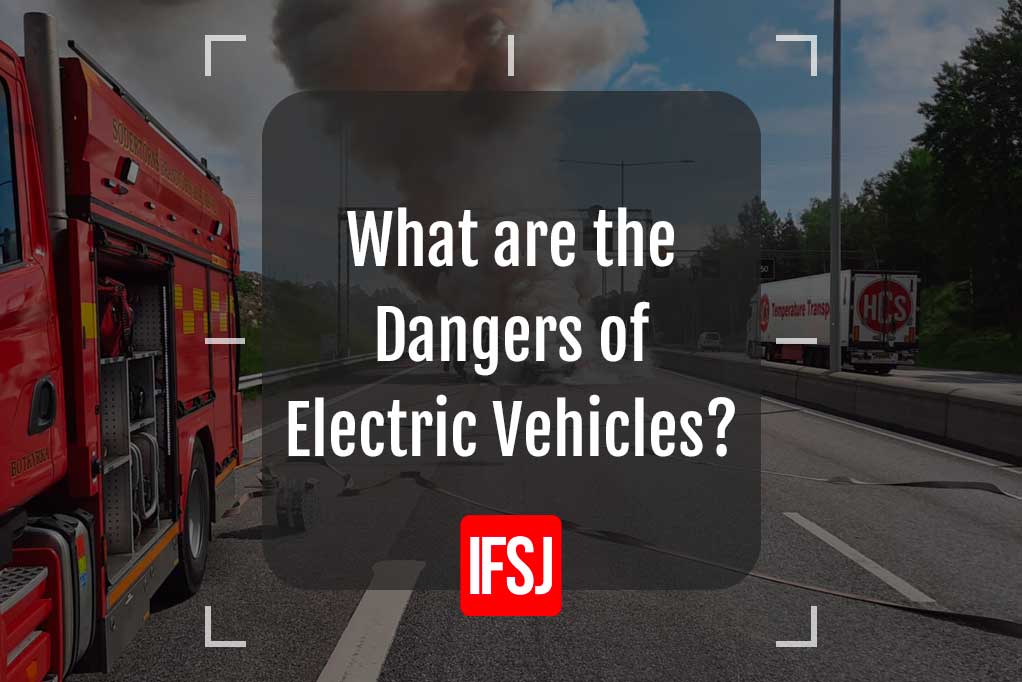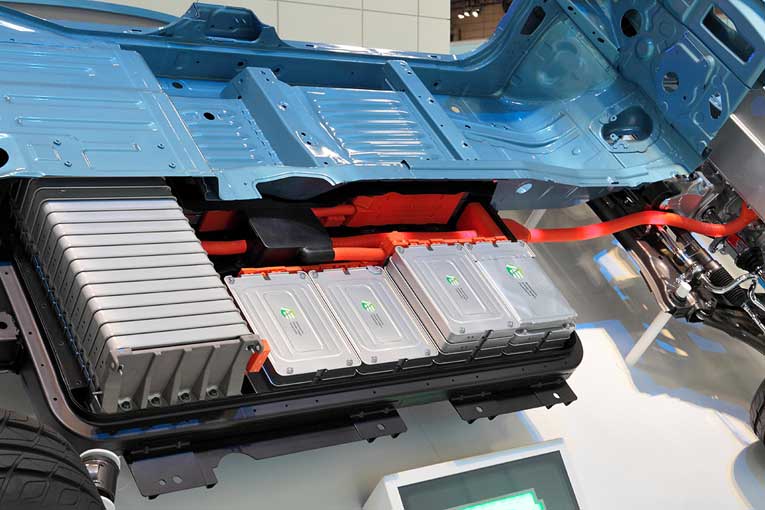What are the Dangers of Electric Vehicles?
- October 21, 2021
- 9:08 am


Iain Hoey
Share this content
With more regulations being forced upon petrol and diesel vehicles, coupled with a public that are placing a greater emphasis on the environment, demand for public use in EV’s is increasing even with the dangers of electric vehicles being very real.
For that reason, it’s important that those using the EV’s are aware of the potential dangers.
One such danger is fire.
In this article, Tommy Carnebo, a firefighter with 21 years’ experience and specialist in fire in electric and gas cars looks to answer some of the most common questions regarding electric vehicle dangers and fires.
Carnebo currently works as a firefighter at Södertörn Fire Protection Association in Stockholm, Sweden but is starting a new position at Dafo Vehicle Fire Protection in Sweden in the upcoming month.
What Happens If You Crash an EV Compared to an ICE Vehicle?

The first thing you have to understand is that every department around the world are aware of the risks of conventional internal combustion engined vehicles and what can happen when they crash.
But the new challenge for us is electric vehicles.
When they crash, they don’t follow the pattern of ordinary cars that we are used to because they are propelled with batteries.
The problem with the electric vehicle is that when they are involved in a high-speed crash, there’s a chance that the battery will be damaged and catch fire.
This is the biggest difference between normal “ice” vehicles and electric vehicles.
With a normal vehicle, there may be some fuel that leaks but we can simply put foam on to the spill.
I have personally been to fire departments in Norway, Sweden and other European countries and I can say with experience that they are not prepared for this type of accident involving electric cars.
Can Electric Vehicles Catch Fire After a Crash?
We have seen a number of cases like this in Sweden.
In fact, as recently as this summer my fire department were on the scene of a crash involving a Tesla and a Volvo.
When the team arrived at the scene, the Tesla was engulfed by fire.
They tried to suppress the fire, but the problem with electric vehicles is that they are so hard to put out that the team left the Tesla and focused on the people who were involved in the crash.
They did put the fire out, but it reignited several times which is also another issue with these vehicles.
They can catch fire again, and again and again.
What’s the Different Between a Normal Car Fire & an EV Fire?
I am currently working at a department in Sweden and for the last couple of years we have had roughly 80 car fires each year.
I would say that 99% of them aren’t catching fire by themselves, because someone is helping them.
With these fires we arrive at the scene and put them out by using 1500 litres of water.
That sounds a lot, but it really isn’t!
With electric vehicles, if the car is running to the state of thermal runaway, we have a real challenge because there is no way we can get the water inside the battery.
We need to do that to extinguish the fire, but the battery pack is sealed which makes getting inside impossible.
When the thermal runaway occurs, there’s an opening that allows us to get some water inside.
But we still have to remain on the scene for a number of hours to make sure that the car doesn’t catch fire again.
When we calculated how much water this uses, we found that we were using between 10,000 to 15,000 litres of water compared to 1,500 on a normal car.
What is a Thermal Runaway?

Thermal runaway occurs when a battery cell has reached the temperature at which the heat will continue to increase on its own and the electrolyte catches fire.
Through this it becomes self-sustaining as it creates oxygen which feeds the fire.
As the heat source and the fuel are both existing within the battery, these fires can develop quickly.
The release of flammable electrolyte makes fire extinguishing very difficult.
In addition, there’s a lot of toxic gases being emitted such as hydrogen fluoride, which can cause serious damage to both the skin and the respiratory tract.
Can You Extinguish a Thermal Runaway in an EV Battery?
So far in Sweden we are using water and there is are a lot of companies working to provide alternatives to water-based solutions.
But the problem is it’s not possible for us to get the water inside the battery.
If you’re going to use water or any other solutions, you need to first get it inside the battery.
Essentially, it’s possible to put the fire out, but you first have to get inside the battery and that’s the biggest problem for fire departments.
When’s Safe to Salvage the Vehicle After a Fire?

Both the fire department and the salvage company have to be educated on how to salvage burnt out electric vehicles.
Essentially, they have to do some background checks on the vehicle before salvaging it.
When those checks have been done, and there’s no smoke from the battery, you can salvage the car.
But it can’t be towed to an ordinary vehicle speed shop because it has to have a quarantine place.
What’s a Quarantine Place & How Long Does an EV Need to Stay There?
At my fire department we’ve produced a document together with three organisations in Sweden that outlines what a quarantine place should look like.
Firstly, it has to have a roof overhead because if the battery is exposed to rainwater, it can start to burn.
Secondly, if there are no concrete walls, there has to be nothing within 10 metres of the vehicle.
You can start to decrease the area if you have concrete walls and if there are some form of monitoring systems in pace in the quarantine place.
What Can Be Done to Make the Quarantine Place Safer?
We’re working with Dafo Vehicle Fire Protection to develop a sensor that can monitor the damaged electric vehicle.
We’re also looking at getting sensors next to and inside the car that can monitor if there is a ventilation or a thermal runaway that is starting so you can get an early warning if there is smoke.
If you have these types of systems in place, you can start to decrease the area of the quarantine place.
With these systems you will also get a warning that there may be a fire starting or something is wrong with the batteries.
The blueprints for this will be produced soon.
If There’s an EV Fire Underground, a Garage Ore on a Ferry, is the Fire Department Equipped to Handle It?
The quick answer to this is no.
The issue with electric cars is they produce a number of toxic gases such as hydrogen fluoride and scientists aren’t sure on how toxic they are.
When these gases enter our skin, there’s a risk that firefighters will be injured, even with breathing apparatus on.
In Sweden we have a time limit of 40 minutes of exposure per person then you have to leave the scene.
The problem with underground fires is that there is so much heat and there is nowhere that we can get rid of the smoke, and of course with electric vehicles they can keep on reigniting.
Cities are now looking to electrify buses, what are the risks?
We need to have some form of monitoring of the batteries because there are some batteries that are usually placed on the bus roof, and as they are fast charging there is always a risk.
Also, as these cities will have a high number of buildings, if there’s a fire the building will have to be evacuated due to the smoke.
Finally, in some cities these buses are going under low bridges.
If one of these buses hits a low bridge, there’s a risk of causing a big fire.
What are your thoughts on the mining industry using electric vehicles?
I have worked with a lot of mining companies and electrical mining can be a good thing, but the batteries are so big that you will have to have monitoring on the batteries and the charging because the mining and charging will be done underground.
You will also need something that will buy some time to allow people to get to the rescue chambers.
Early detection of potential battery failure together with rapid cooling is key to effectively stopping, or delaying a potentially hazardous situation without the fire developing further.
For this reason, Dafo Vehicle Fire Protection has developed a specific risk mitigation solution.
About the Author
Tommy Carnebo, is a Risk Management Specialist at Dafo Vehicle Fire Protection.
He’s written and published a wide range of editorial pieces and articles on some of the most common questions on electric vehicle dangers.



